Financial Decisions Making for Managers
VerifiedAdded on 2019/12/17
|14
|4616
|85
Report
AI Summary
This report provides a comprehensive analysis of financial decision-making for managers. It includes a detailed ratio analysis of Sainsbury's financial performance over two years, comments on its business and financial structure, and advice for potential investors. The report also explores various finance sources, prepares a cash flow budget for Green Limited, and assesses investment appraisal techniques for Hanley Manufacturing Limited. The analysis covers working capital management, cash flow management, and recommendations for improving financial performance. The report concludes with key findings and recommendations for each case study.
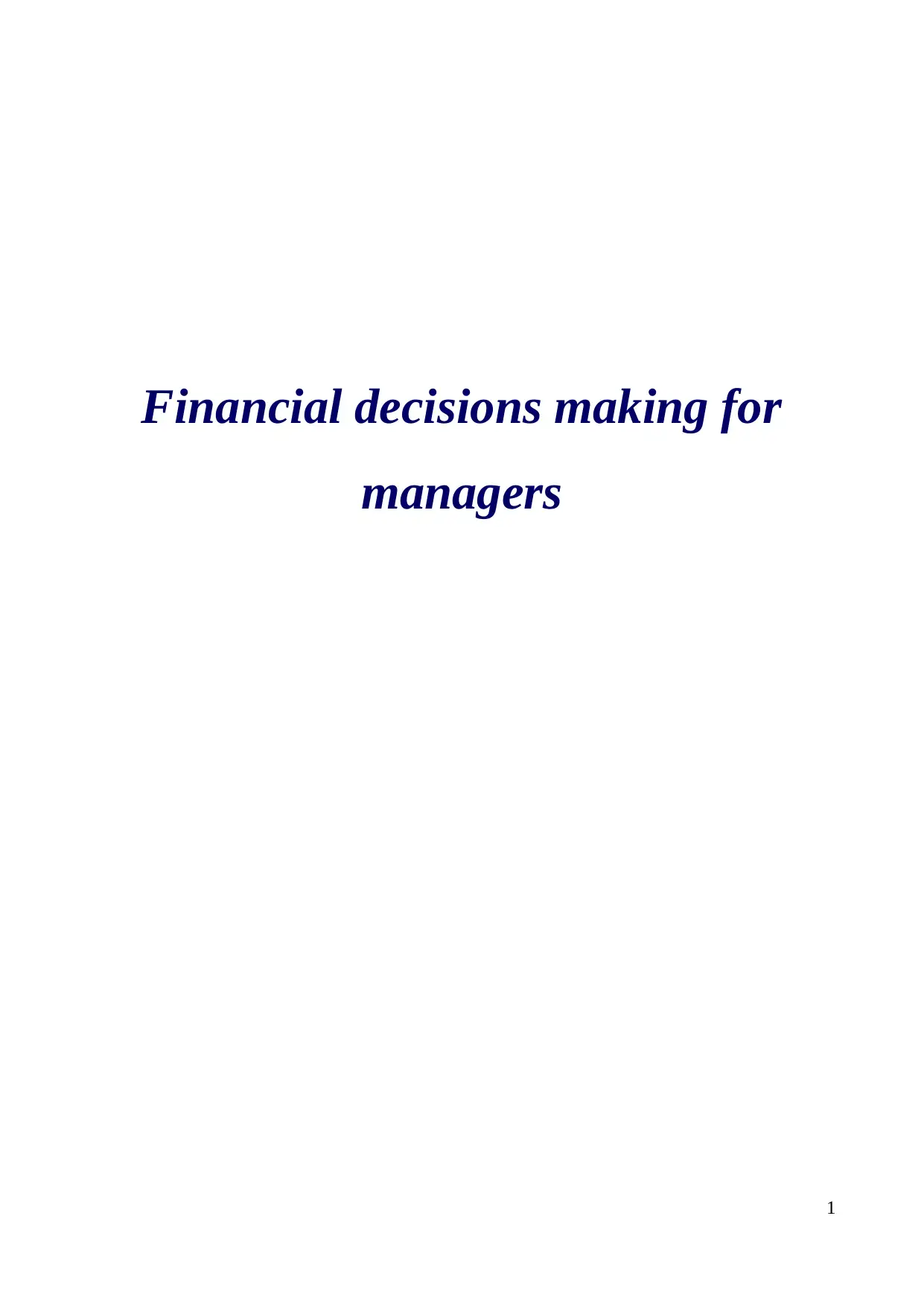
Financial decisions making for
managers
1
managers
1
Paraphrase This Document
Need a fresh take? Get an instant paraphrase of this document with our AI Paraphraser
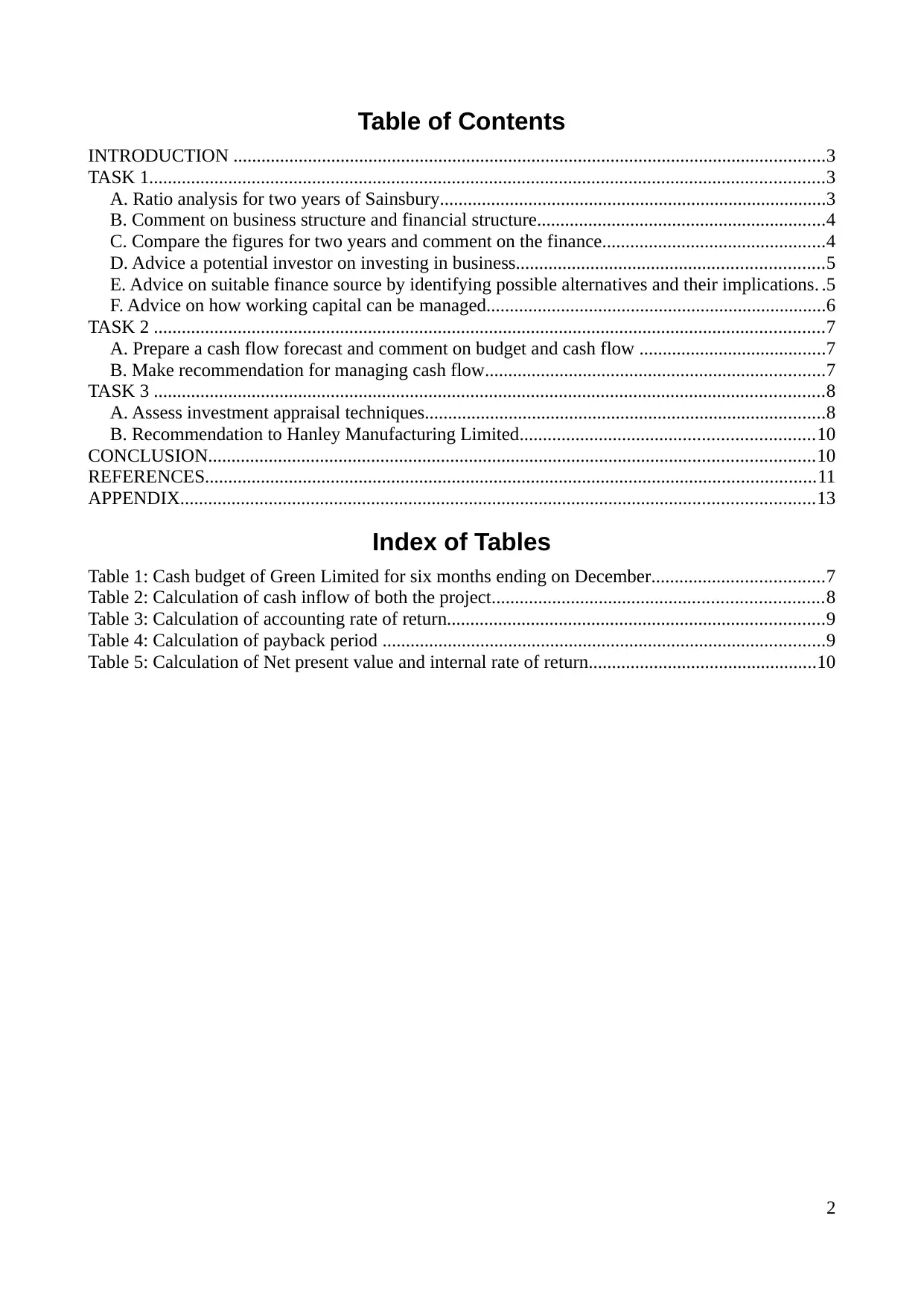
Table of Contents
INTRODUCTION ...............................................................................................................................3
TASK 1.................................................................................................................................................3
A. Ratio analysis for two years of Sainsbury...................................................................................3
B. Comment on business structure and financial structure..............................................................4
C. Compare the figures for two years and comment on the finance................................................4
D. Advice a potential investor on investing in business..................................................................5
E. Advice on suitable finance source by identifying possible alternatives and their implications. .5
F. Advice on how working capital can be managed.........................................................................6
TASK 2 ................................................................................................................................................7
A. Prepare a cash flow forecast and comment on budget and cash flow ........................................7
B. Make recommendation for managing cash flow.........................................................................7
TASK 3 ................................................................................................................................................8
A. Assess investment appraisal techniques......................................................................................8
B. Recommendation to Hanley Manufacturing Limited...............................................................10
CONCLUSION..................................................................................................................................10
REFERENCES...................................................................................................................................11
APPENDIX........................................................................................................................................13
Index of Tables
Table 1: Cash budget of Green Limited for six months ending on December.....................................7
Table 2: Calculation of cash inflow of both the project.......................................................................8
Table 3: Calculation of accounting rate of return.................................................................................9
Table 4: Calculation of payback period ...............................................................................................9
Table 5: Calculation of Net present value and internal rate of return.................................................10
2
INTRODUCTION ...............................................................................................................................3
TASK 1.................................................................................................................................................3
A. Ratio analysis for two years of Sainsbury...................................................................................3
B. Comment on business structure and financial structure..............................................................4
C. Compare the figures for two years and comment on the finance................................................4
D. Advice a potential investor on investing in business..................................................................5
E. Advice on suitable finance source by identifying possible alternatives and their implications. .5
F. Advice on how working capital can be managed.........................................................................6
TASK 2 ................................................................................................................................................7
A. Prepare a cash flow forecast and comment on budget and cash flow ........................................7
B. Make recommendation for managing cash flow.........................................................................7
TASK 3 ................................................................................................................................................8
A. Assess investment appraisal techniques......................................................................................8
B. Recommendation to Hanley Manufacturing Limited...............................................................10
CONCLUSION..................................................................................................................................10
REFERENCES...................................................................................................................................11
APPENDIX........................................................................................................................................13
Index of Tables
Table 1: Cash budget of Green Limited for six months ending on December.....................................7
Table 2: Calculation of cash inflow of both the project.......................................................................8
Table 3: Calculation of accounting rate of return.................................................................................9
Table 4: Calculation of payback period ...............................................................................................9
Table 5: Calculation of Net present value and internal rate of return.................................................10
2
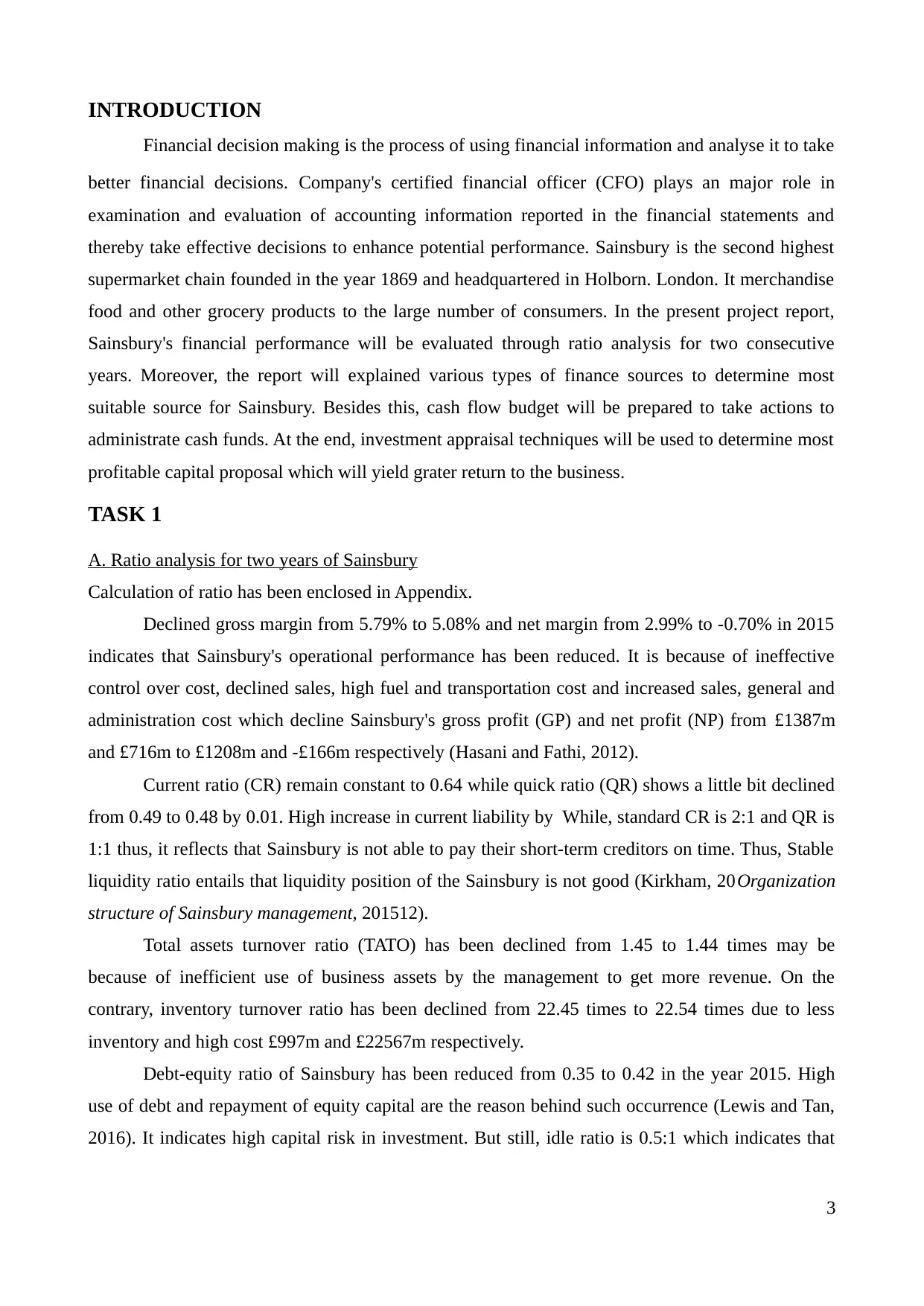
INTRODUCTION
Financial decision making is the process of using financial information and analyse it to take
better financial decisions. Company's certified financial officer (CFO) plays an major role in
examination and evaluation of accounting information reported in the financial statements and
thereby take effective decisions to enhance potential performance. Sainsbury is the second highest
supermarket chain founded in the year 1869 and headquartered in Holborn. London. It merchandise
food and other grocery products to the large number of consumers. In the present project report,
Sainsbury's financial performance will be evaluated through ratio analysis for two consecutive
years. Moreover, the report will explained various types of finance sources to determine most
suitable source for Sainsbury. Besides this, cash flow budget will be prepared to take actions to
administrate cash funds. At the end, investment appraisal techniques will be used to determine most
profitable capital proposal which will yield grater return to the business.
TASK 1
A. Ratio analysis for two years of Sainsbury
Calculation of ratio has been enclosed in Appendix.
Declined gross margin from 5.79% to 5.08% and net margin from 2.99% to -0.70% in 2015
indicates that Sainsbury's operational performance has been reduced. It is because of ineffective
control over cost, declined sales, high fuel and transportation cost and increased sales, general and
administration cost which decline Sainsbury's gross profit (GP) and net profit (NP) from £1387m
and £716m to £1208m and -£166m respectively (Hasani and Fathi, 2012).
Current ratio (CR) remain constant to 0.64 while quick ratio (QR) shows a little bit declined
from 0.49 to 0.48 by 0.01. High increase in current liability by While, standard CR is 2:1 and QR is
1:1 thus, it reflects that Sainsbury is not able to pay their short-term creditors on time. Thus, Stable
liquidity ratio entails that liquidity position of the Sainsbury is not good (Kirkham, 20Organization
structure of Sainsbury management, 201512).
Total assets turnover ratio (TATO) has been declined from 1.45 to 1.44 times may be
because of inefficient use of business assets by the management to get more revenue. On the
contrary, inventory turnover ratio has been declined from 22.45 times to 22.54 times due to less
inventory and high cost £997m and £22567m respectively.
Debt-equity ratio of Sainsbury has been reduced from 0.35 to 0.42 in the year 2015. High
use of debt and repayment of equity capital are the reason behind such occurrence (Lewis and Tan,
2016). It indicates high capital risk in investment. But still, idle ratio is 0.5:1 which indicates that
3
Financial decision making is the process of using financial information and analyse it to take
better financial decisions. Company's certified financial officer (CFO) plays an major role in
examination and evaluation of accounting information reported in the financial statements and
thereby take effective decisions to enhance potential performance. Sainsbury is the second highest
supermarket chain founded in the year 1869 and headquartered in Holborn. London. It merchandise
food and other grocery products to the large number of consumers. In the present project report,
Sainsbury's financial performance will be evaluated through ratio analysis for two consecutive
years. Moreover, the report will explained various types of finance sources to determine most
suitable source for Sainsbury. Besides this, cash flow budget will be prepared to take actions to
administrate cash funds. At the end, investment appraisal techniques will be used to determine most
profitable capital proposal which will yield grater return to the business.
TASK 1
A. Ratio analysis for two years of Sainsbury
Calculation of ratio has been enclosed in Appendix.
Declined gross margin from 5.79% to 5.08% and net margin from 2.99% to -0.70% in 2015
indicates that Sainsbury's operational performance has been reduced. It is because of ineffective
control over cost, declined sales, high fuel and transportation cost and increased sales, general and
administration cost which decline Sainsbury's gross profit (GP) and net profit (NP) from £1387m
and £716m to £1208m and -£166m respectively (Hasani and Fathi, 2012).
Current ratio (CR) remain constant to 0.64 while quick ratio (QR) shows a little bit declined
from 0.49 to 0.48 by 0.01. High increase in current liability by While, standard CR is 2:1 and QR is
1:1 thus, it reflects that Sainsbury is not able to pay their short-term creditors on time. Thus, Stable
liquidity ratio entails that liquidity position of the Sainsbury is not good (Kirkham, 20Organization
structure of Sainsbury management, 201512).
Total assets turnover ratio (TATO) has been declined from 1.45 to 1.44 times may be
because of inefficient use of business assets by the management to get more revenue. On the
contrary, inventory turnover ratio has been declined from 22.45 times to 22.54 times due to less
inventory and high cost £997m and £22567m respectively.
Debt-equity ratio of Sainsbury has been reduced from 0.35 to 0.42 in the year 2015. High
use of debt and repayment of equity capital are the reason behind such occurrence (Lewis and Tan,
2016). It indicates high capital risk in investment. But still, idle ratio is 0.5:1 which indicates that
3
⊘ This is a preview!⊘
Do you want full access?
Subscribe today to unlock all pages.

Trusted by 1+ million students worldwide
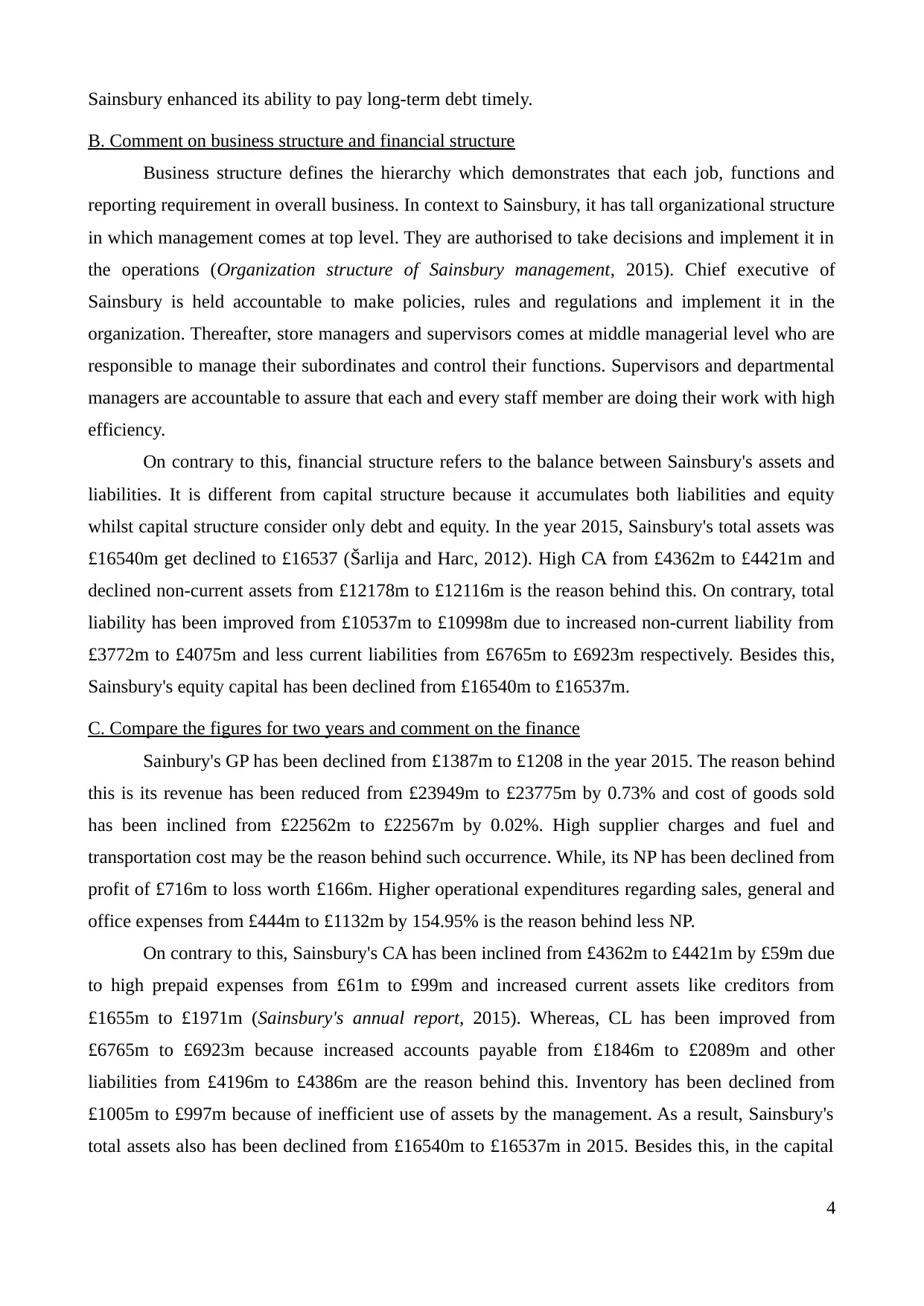
Sainsbury enhanced its ability to pay long-term debt timely.
B. Comment on business structure and financial structure
Business structure defines the hierarchy which demonstrates that each job, functions and
reporting requirement in overall business. In context to Sainsbury, it has tall organizational structure
in which management comes at top level. They are authorised to take decisions and implement it in
the operations (Organization structure of Sainsbury management, 2015). Chief executive of
Sainsbury is held accountable to make policies, rules and regulations and implement it in the
organization. Thereafter, store managers and supervisors comes at middle managerial level who are
responsible to manage their subordinates and control their functions. Supervisors and departmental
managers are accountable to assure that each and every staff member are doing their work with high
efficiency.
On contrary to this, financial structure refers to the balance between Sainsbury's assets and
liabilities. It is different from capital structure because it accumulates both liabilities and equity
whilst capital structure consider only debt and equity. In the year 2015, Sainsbury's total assets was
£16540m get declined to £16537 (Šarlija and Harc, 2012). High CA from £4362m to £4421m and
declined non-current assets from £12178m to £12116m is the reason behind this. On contrary, total
liability has been improved from £10537m to £10998m due to increased non-current liability from
£3772m to £4075m and less current liabilities from £6765m to £6923m respectively. Besides this,
Sainsbury's equity capital has been declined from £16540m to £16537m.
C. Compare the figures for two years and comment on the finance
Sainbury's GP has been declined from £1387m to £1208 in the year 2015. The reason behind
this is its revenue has been reduced from £23949m to £23775m by 0.73% and cost of goods sold
has been inclined from £22562m to £22567m by 0.02%. High supplier charges and fuel and
transportation cost may be the reason behind such occurrence. While, its NP has been declined from
profit of £716m to loss worth £166m. Higher operational expenditures regarding sales, general and
office expenses from £444m to £1132m by 154.95% is the reason behind less NP.
On contrary to this, Sainsbury's CA has been inclined from £4362m to £4421m by £59m due
to high prepaid expenses from £61m to £99m and increased current assets like creditors from
£1655m to £1971m (Sainsbury's annual report, 2015). Whereas, CL has been improved from
£6765m to £6923m because increased accounts payable from £1846m to £2089m and other
liabilities from £4196m to £4386m are the reason behind this. Inventory has been declined from
£1005m to £997m because of inefficient use of assets by the management. As a result, Sainsbury's
total assets also has been declined from £16540m to £16537m in 2015. Besides this, in the capital
4
B. Comment on business structure and financial structure
Business structure defines the hierarchy which demonstrates that each job, functions and
reporting requirement in overall business. In context to Sainsbury, it has tall organizational structure
in which management comes at top level. They are authorised to take decisions and implement it in
the operations (Organization structure of Sainsbury management, 2015). Chief executive of
Sainsbury is held accountable to make policies, rules and regulations and implement it in the
organization. Thereafter, store managers and supervisors comes at middle managerial level who are
responsible to manage their subordinates and control their functions. Supervisors and departmental
managers are accountable to assure that each and every staff member are doing their work with high
efficiency.
On contrary to this, financial structure refers to the balance between Sainsbury's assets and
liabilities. It is different from capital structure because it accumulates both liabilities and equity
whilst capital structure consider only debt and equity. In the year 2015, Sainsbury's total assets was
£16540m get declined to £16537 (Šarlija and Harc, 2012). High CA from £4362m to £4421m and
declined non-current assets from £12178m to £12116m is the reason behind this. On contrary, total
liability has been improved from £10537m to £10998m due to increased non-current liability from
£3772m to £4075m and less current liabilities from £6765m to £6923m respectively. Besides this,
Sainsbury's equity capital has been declined from £16540m to £16537m.
C. Compare the figures for two years and comment on the finance
Sainbury's GP has been declined from £1387m to £1208 in the year 2015. The reason behind
this is its revenue has been reduced from £23949m to £23775m by 0.73% and cost of goods sold
has been inclined from £22562m to £22567m by 0.02%. High supplier charges and fuel and
transportation cost may be the reason behind such occurrence. While, its NP has been declined from
profit of £716m to loss worth £166m. Higher operational expenditures regarding sales, general and
office expenses from £444m to £1132m by 154.95% is the reason behind less NP.
On contrary to this, Sainsbury's CA has been inclined from £4362m to £4421m by £59m due
to high prepaid expenses from £61m to £99m and increased current assets like creditors from
£1655m to £1971m (Sainsbury's annual report, 2015). Whereas, CL has been improved from
£6765m to £6923m because increased accounts payable from £1846m to £2089m and other
liabilities from £4196m to £4386m are the reason behind this. Inventory has been declined from
£1005m to £997m because of inefficient use of assets by the management. As a result, Sainsbury's
total assets also has been declined from £16540m to £16537m in 2015. Besides this, in the capital
4
Paraphrase This Document
Need a fresh take? Get an instant paraphrase of this document with our AI Paraphraser
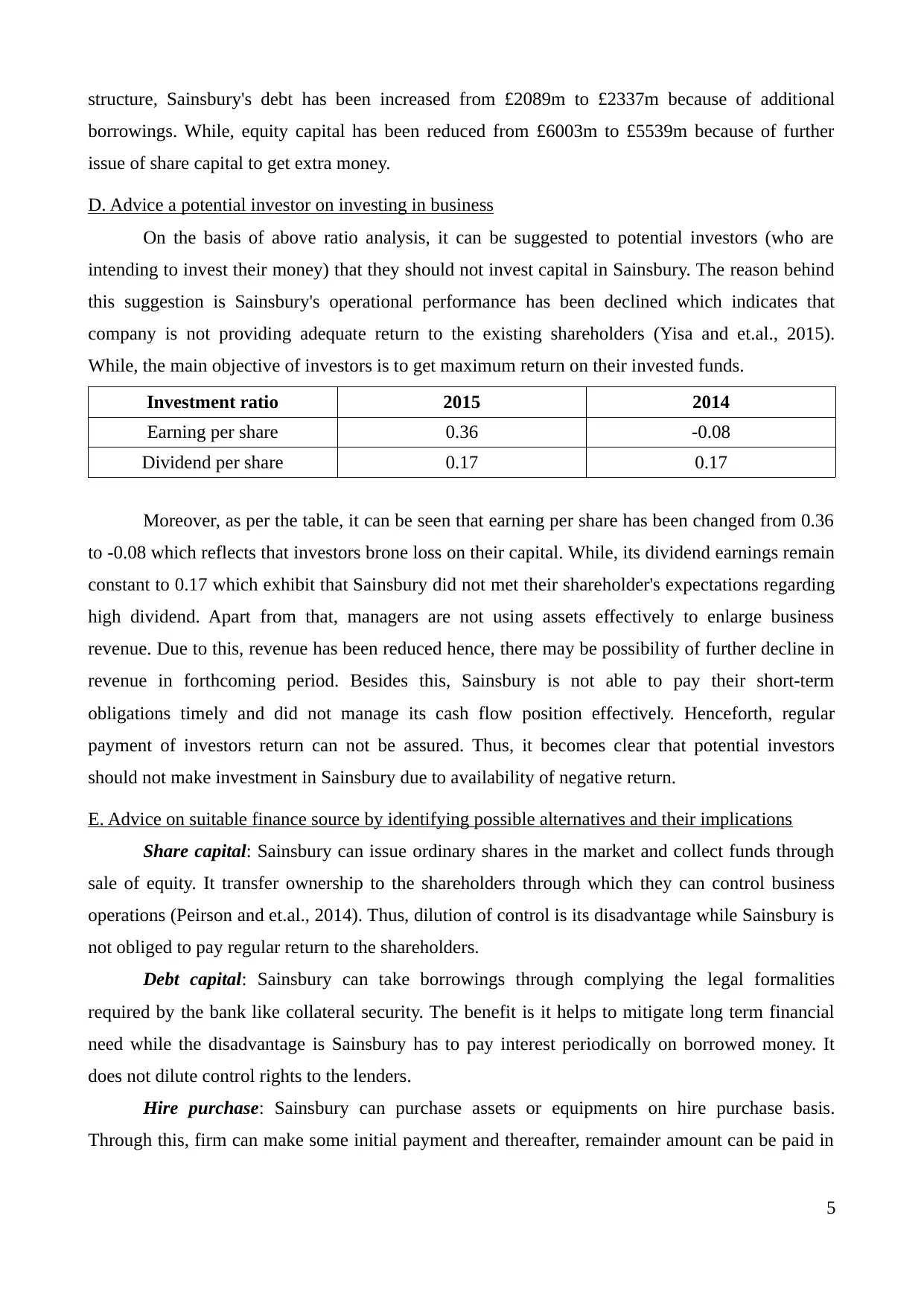
structure, Sainsbury's debt has been increased from £2089m to £2337m because of additional
borrowings. While, equity capital has been reduced from £6003m to £5539m because of further
issue of share capital to get extra money.
D. Advice a potential investor on investing in business
On the basis of above ratio analysis, it can be suggested to potential investors (who are
intending to invest their money) that they should not invest capital in Sainsbury. The reason behind
this suggestion is Sainsbury's operational performance has been declined which indicates that
company is not providing adequate return to the existing shareholders (Yisa and et.al., 2015).
While, the main objective of investors is to get maximum return on their invested funds.
Investment ratio 2015 2014
Earning per share 0.36 -0.08
Dividend per share 0.17 0.17
Moreover, as per the table, it can be seen that earning per share has been changed from 0.36
to -0.08 which reflects that investors brone loss on their capital. While, its dividend earnings remain
constant to 0.17 which exhibit that Sainsbury did not met their shareholder's expectations regarding
high dividend. Apart from that, managers are not using assets effectively to enlarge business
revenue. Due to this, revenue has been reduced hence, there may be possibility of further decline in
revenue in forthcoming period. Besides this, Sainsbury is not able to pay their short-term
obligations timely and did not manage its cash flow position effectively. Henceforth, regular
payment of investors return can not be assured. Thus, it becomes clear that potential investors
should not make investment in Sainsbury due to availability of negative return.
E. Advice on suitable finance source by identifying possible alternatives and their implications
Share capital: Sainsbury can issue ordinary shares in the market and collect funds through
sale of equity. It transfer ownership to the shareholders through which they can control business
operations (Peirson and et.al., 2014). Thus, dilution of control is its disadvantage while Sainsbury is
not obliged to pay regular return to the shareholders.
Debt capital: Sainsbury can take borrowings through complying the legal formalities
required by the bank like collateral security. The benefit is it helps to mitigate long term financial
need while the disadvantage is Sainsbury has to pay interest periodically on borrowed money. It
does not dilute control rights to the lenders.
Hire purchase: Sainsbury can purchase assets or equipments on hire purchase basis.
Through this, firm can make some initial payment and thereafter, remainder amount can be paid in
5
borrowings. While, equity capital has been reduced from £6003m to £5539m because of further
issue of share capital to get extra money.
D. Advice a potential investor on investing in business
On the basis of above ratio analysis, it can be suggested to potential investors (who are
intending to invest their money) that they should not invest capital in Sainsbury. The reason behind
this suggestion is Sainsbury's operational performance has been declined which indicates that
company is not providing adequate return to the existing shareholders (Yisa and et.al., 2015).
While, the main objective of investors is to get maximum return on their invested funds.
Investment ratio 2015 2014
Earning per share 0.36 -0.08
Dividend per share 0.17 0.17
Moreover, as per the table, it can be seen that earning per share has been changed from 0.36
to -0.08 which reflects that investors brone loss on their capital. While, its dividend earnings remain
constant to 0.17 which exhibit that Sainsbury did not met their shareholder's expectations regarding
high dividend. Apart from that, managers are not using assets effectively to enlarge business
revenue. Due to this, revenue has been reduced hence, there may be possibility of further decline in
revenue in forthcoming period. Besides this, Sainsbury is not able to pay their short-term
obligations timely and did not manage its cash flow position effectively. Henceforth, regular
payment of investors return can not be assured. Thus, it becomes clear that potential investors
should not make investment in Sainsbury due to availability of negative return.
E. Advice on suitable finance source by identifying possible alternatives and their implications
Share capital: Sainsbury can issue ordinary shares in the market and collect funds through
sale of equity. It transfer ownership to the shareholders through which they can control business
operations (Peirson and et.al., 2014). Thus, dilution of control is its disadvantage while Sainsbury is
not obliged to pay regular return to the shareholders.
Debt capital: Sainsbury can take borrowings through complying the legal formalities
required by the bank like collateral security. The benefit is it helps to mitigate long term financial
need while the disadvantage is Sainsbury has to pay interest periodically on borrowed money. It
does not dilute control rights to the lenders.
Hire purchase: Sainsbury can purchase assets or equipments on hire purchase basis.
Through this, firm can make some initial payment and thereafter, remainder amount can be paid in
5
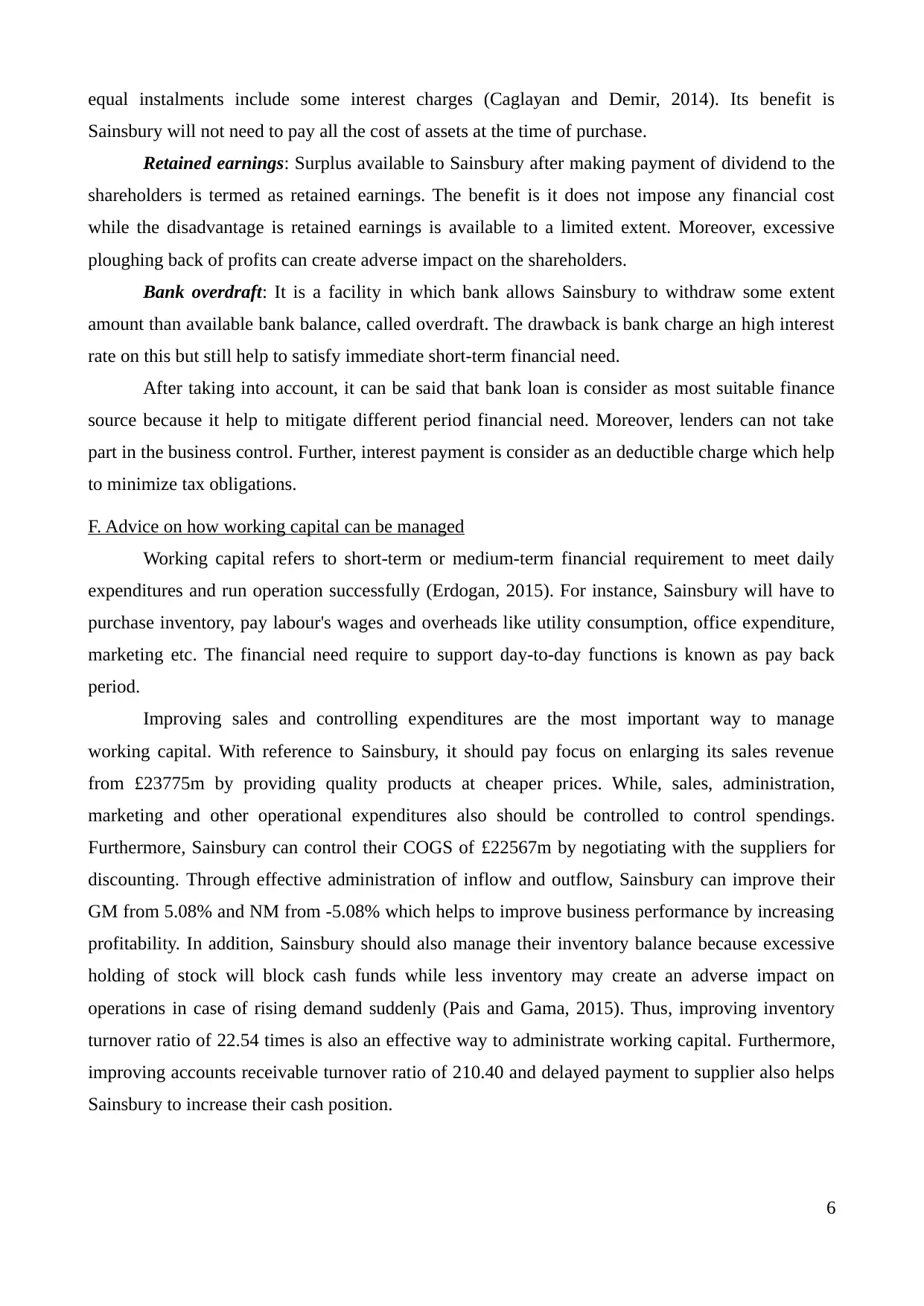
equal instalments include some interest charges (Caglayan and Demir, 2014). Its benefit is
Sainsbury will not need to pay all the cost of assets at the time of purchase.
Retained earnings: Surplus available to Sainsbury after making payment of dividend to the
shareholders is termed as retained earnings. The benefit is it does not impose any financial cost
while the disadvantage is retained earnings is available to a limited extent. Moreover, excessive
ploughing back of profits can create adverse impact on the shareholders.
Bank overdraft: It is a facility in which bank allows Sainsbury to withdraw some extent
amount than available bank balance, called overdraft. The drawback is bank charge an high interest
rate on this but still help to satisfy immediate short-term financial need.
After taking into account, it can be said that bank loan is consider as most suitable finance
source because it help to mitigate different period financial need. Moreover, lenders can not take
part in the business control. Further, interest payment is consider as an deductible charge which help
to minimize tax obligations.
F. Advice on how working capital can be managed
Working capital refers to short-term or medium-term financial requirement to meet daily
expenditures and run operation successfully (Erdogan, 2015). For instance, Sainsbury will have to
purchase inventory, pay labour's wages and overheads like utility consumption, office expenditure,
marketing etc. The financial need require to support day-to-day functions is known as pay back
period.
Improving sales and controlling expenditures are the most important way to manage
working capital. With reference to Sainsbury, it should pay focus on enlarging its sales revenue
from £23775m by providing quality products at cheaper prices. While, sales, administration,
marketing and other operational expenditures also should be controlled to control spendings.
Furthermore, Sainsbury can control their COGS of £22567m by negotiating with the suppliers for
discounting. Through effective administration of inflow and outflow, Sainsbury can improve their
GM from 5.08% and NM from -5.08% which helps to improve business performance by increasing
profitability. In addition, Sainsbury should also manage their inventory balance because excessive
holding of stock will block cash funds while less inventory may create an adverse impact on
operations in case of rising demand suddenly (Pais and Gama, 2015). Thus, improving inventory
turnover ratio of 22.54 times is also an effective way to administrate working capital. Furthermore,
improving accounts receivable turnover ratio of 210.40 and delayed payment to supplier also helps
Sainsbury to increase their cash position.
6
Sainsbury will not need to pay all the cost of assets at the time of purchase.
Retained earnings: Surplus available to Sainsbury after making payment of dividend to the
shareholders is termed as retained earnings. The benefit is it does not impose any financial cost
while the disadvantage is retained earnings is available to a limited extent. Moreover, excessive
ploughing back of profits can create adverse impact on the shareholders.
Bank overdraft: It is a facility in which bank allows Sainsbury to withdraw some extent
amount than available bank balance, called overdraft. The drawback is bank charge an high interest
rate on this but still help to satisfy immediate short-term financial need.
After taking into account, it can be said that bank loan is consider as most suitable finance
source because it help to mitigate different period financial need. Moreover, lenders can not take
part in the business control. Further, interest payment is consider as an deductible charge which help
to minimize tax obligations.
F. Advice on how working capital can be managed
Working capital refers to short-term or medium-term financial requirement to meet daily
expenditures and run operation successfully (Erdogan, 2015). For instance, Sainsbury will have to
purchase inventory, pay labour's wages and overheads like utility consumption, office expenditure,
marketing etc. The financial need require to support day-to-day functions is known as pay back
period.
Improving sales and controlling expenditures are the most important way to manage
working capital. With reference to Sainsbury, it should pay focus on enlarging its sales revenue
from £23775m by providing quality products at cheaper prices. While, sales, administration,
marketing and other operational expenditures also should be controlled to control spendings.
Furthermore, Sainsbury can control their COGS of £22567m by negotiating with the suppliers for
discounting. Through effective administration of inflow and outflow, Sainsbury can improve their
GM from 5.08% and NM from -5.08% which helps to improve business performance by increasing
profitability. In addition, Sainsbury should also manage their inventory balance because excessive
holding of stock will block cash funds while less inventory may create an adverse impact on
operations in case of rising demand suddenly (Pais and Gama, 2015). Thus, improving inventory
turnover ratio of 22.54 times is also an effective way to administrate working capital. Furthermore,
improving accounts receivable turnover ratio of 210.40 and delayed payment to supplier also helps
Sainsbury to increase their cash position.
6
⊘ This is a preview!⊘
Do you want full access?
Subscribe today to unlock all pages.

Trusted by 1+ million students worldwide
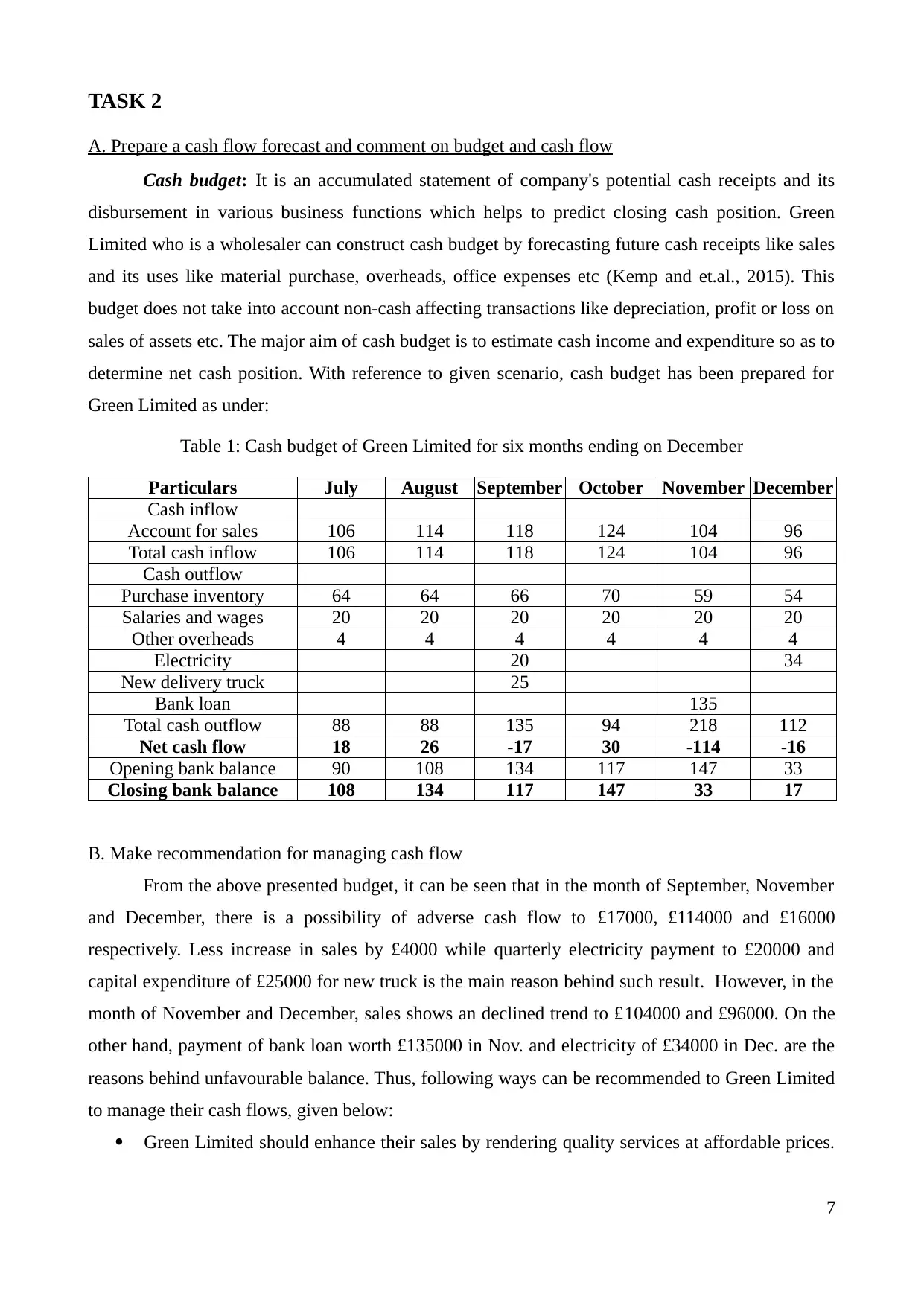
TASK 2
A. Prepare a cash flow forecast and comment on budget and cash flow
Cash budget: It is an accumulated statement of company's potential cash receipts and its
disbursement in various business functions which helps to predict closing cash position. Green
Limited who is a wholesaler can construct cash budget by forecasting future cash receipts like sales
and its uses like material purchase, overheads, office expenses etc (Kemp and et.al., 2015). This
budget does not take into account non-cash affecting transactions like depreciation, profit or loss on
sales of assets etc. The major aim of cash budget is to estimate cash income and expenditure so as to
determine net cash position. With reference to given scenario, cash budget has been prepared for
Green Limited as under:
Table 1: Cash budget of Green Limited for six months ending on December
Particulars July August September October November December
Cash inflow
Account for sales 106 114 118 124 104 96
Total cash inflow 106 114 118 124 104 96
Cash outflow
Purchase inventory 64 64 66 70 59 54
Salaries and wages 20 20 20 20 20 20
Other overheads 4 4 4 4 4 4
Electricity 20 34
New delivery truck 25
Bank loan 135
Total cash outflow 88 88 135 94 218 112
Net cash flow 18 26 -17 30 -114 -16
Opening bank balance 90 108 134 117 147 33
Closing bank balance 108 134 117 147 33 17
B. Make recommendation for managing cash flow
From the above presented budget, it can be seen that in the month of September, November
and December, there is a possibility of adverse cash flow to £17000, £114000 and £16000
respectively. Less increase in sales by £4000 while quarterly electricity payment to £20000 and
capital expenditure of £25000 for new truck is the main reason behind such result. However, in the
month of November and December, sales shows an declined trend to £104000 and £96000. On the
other hand, payment of bank loan worth £135000 in Nov. and electricity of £34000 in Dec. are the
reasons behind unfavourable balance. Thus, following ways can be recommended to Green Limited
to manage their cash flows, given below:
Green Limited should enhance their sales by rendering quality services at affordable prices.
7
A. Prepare a cash flow forecast and comment on budget and cash flow
Cash budget: It is an accumulated statement of company's potential cash receipts and its
disbursement in various business functions which helps to predict closing cash position. Green
Limited who is a wholesaler can construct cash budget by forecasting future cash receipts like sales
and its uses like material purchase, overheads, office expenses etc (Kemp and et.al., 2015). This
budget does not take into account non-cash affecting transactions like depreciation, profit or loss on
sales of assets etc. The major aim of cash budget is to estimate cash income and expenditure so as to
determine net cash position. With reference to given scenario, cash budget has been prepared for
Green Limited as under:
Table 1: Cash budget of Green Limited for six months ending on December
Particulars July August September October November December
Cash inflow
Account for sales 106 114 118 124 104 96
Total cash inflow 106 114 118 124 104 96
Cash outflow
Purchase inventory 64 64 66 70 59 54
Salaries and wages 20 20 20 20 20 20
Other overheads 4 4 4 4 4 4
Electricity 20 34
New delivery truck 25
Bank loan 135
Total cash outflow 88 88 135 94 218 112
Net cash flow 18 26 -17 30 -114 -16
Opening bank balance 90 108 134 117 147 33
Closing bank balance 108 134 117 147 33 17
B. Make recommendation for managing cash flow
From the above presented budget, it can be seen that in the month of September, November
and December, there is a possibility of adverse cash flow to £17000, £114000 and £16000
respectively. Less increase in sales by £4000 while quarterly electricity payment to £20000 and
capital expenditure of £25000 for new truck is the main reason behind such result. However, in the
month of November and December, sales shows an declined trend to £104000 and £96000. On the
other hand, payment of bank loan worth £135000 in Nov. and electricity of £34000 in Dec. are the
reasons behind unfavourable balance. Thus, following ways can be recommended to Green Limited
to manage their cash flows, given below:
Green Limited should enhance their sales by rendering quality services at affordable prices.
7
Paraphrase This Document
Need a fresh take? Get an instant paraphrase of this document with our AI Paraphraser
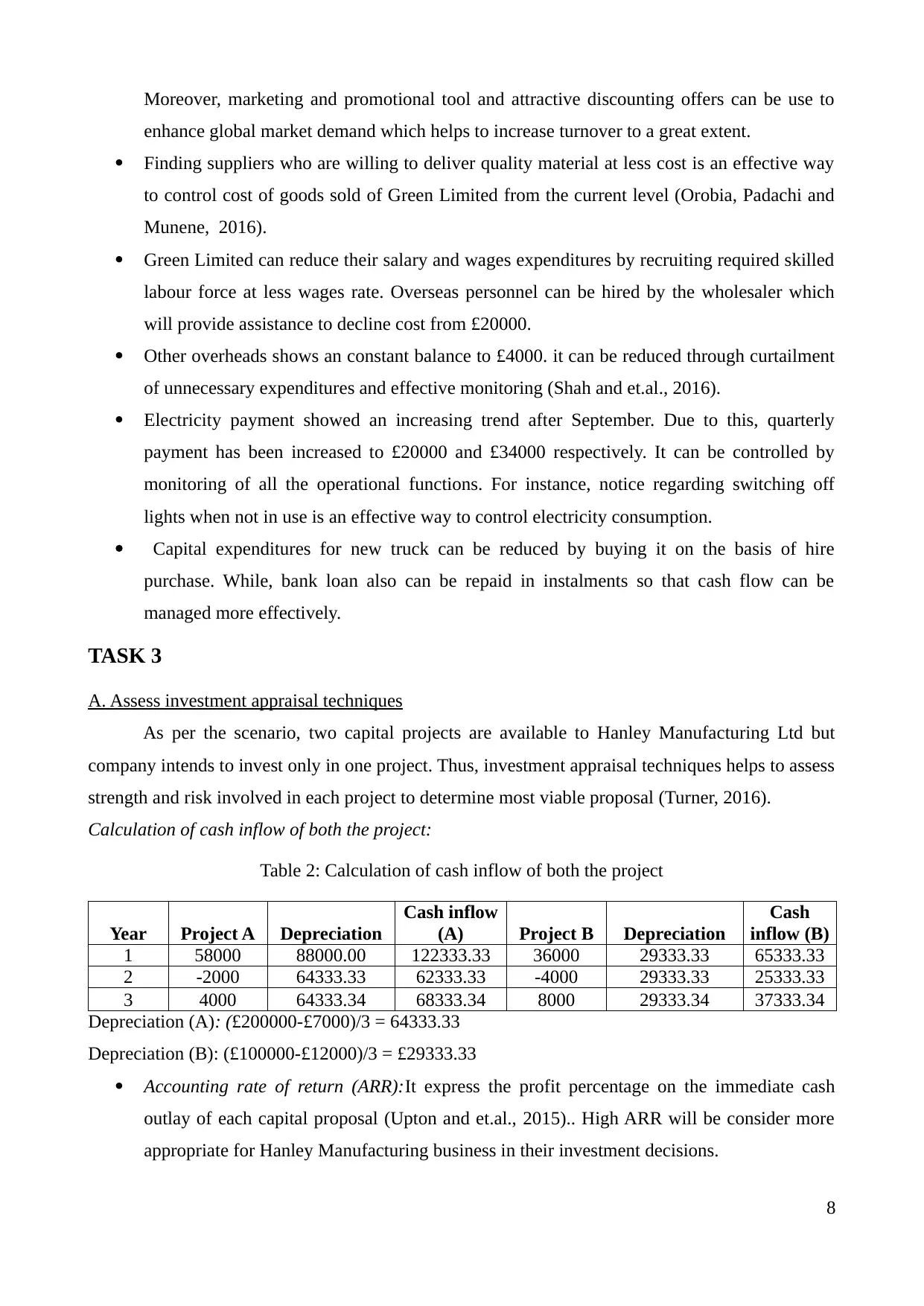
Moreover, marketing and promotional tool and attractive discounting offers can be use to
enhance global market demand which helps to increase turnover to a great extent.
Finding suppliers who are willing to deliver quality material at less cost is an effective way
to control cost of goods sold of Green Limited from the current level (Orobia, Padachi and
Munene, 2016).
Green Limited can reduce their salary and wages expenditures by recruiting required skilled
labour force at less wages rate. Overseas personnel can be hired by the wholesaler which
will provide assistance to decline cost from £20000.
Other overheads shows an constant balance to £4000. it can be reduced through curtailment
of unnecessary expenditures and effective monitoring (Shah and et.al., 2016).
Electricity payment showed an increasing trend after September. Due to this, quarterly
payment has been increased to £20000 and £34000 respectively. It can be controlled by
monitoring of all the operational functions. For instance, notice regarding switching off
lights when not in use is an effective way to control electricity consumption.
Capital expenditures for new truck can be reduced by buying it on the basis of hire
purchase. While, bank loan also can be repaid in instalments so that cash flow can be
managed more effectively.
TASK 3
A. Assess investment appraisal techniques
As per the scenario, two capital projects are available to Hanley Manufacturing Ltd but
company intends to invest only in one project. Thus, investment appraisal techniques helps to assess
strength and risk involved in each project to determine most viable proposal (Turner, 2016).
Calculation of cash inflow of both the project:
Table 2: Calculation of cash inflow of both the project
Year Project A Depreciation
Cash inflow
(A) Project B Depreciation
Cash
inflow (B)
1 58000 88000.00 122333.33 36000 29333.33 65333.33
2 -2000 64333.33 62333.33 -4000 29333.33 25333.33
3 4000 64333.34 68333.34 8000 29333.34 37333.34
Depreciation (A): (£200000-£7000)/3 = 64333.33
Depreciation (B): (£100000-£12000)/3 = £29333.33
Accounting rate of return (ARR):It express the profit percentage on the immediate cash
outlay of each capital proposal (Upton and et.al., 2015).. High ARR will be consider more
appropriate for Hanley Manufacturing business in their investment decisions.
8
enhance global market demand which helps to increase turnover to a great extent.
Finding suppliers who are willing to deliver quality material at less cost is an effective way
to control cost of goods sold of Green Limited from the current level (Orobia, Padachi and
Munene, 2016).
Green Limited can reduce their salary and wages expenditures by recruiting required skilled
labour force at less wages rate. Overseas personnel can be hired by the wholesaler which
will provide assistance to decline cost from £20000.
Other overheads shows an constant balance to £4000. it can be reduced through curtailment
of unnecessary expenditures and effective monitoring (Shah and et.al., 2016).
Electricity payment showed an increasing trend after September. Due to this, quarterly
payment has been increased to £20000 and £34000 respectively. It can be controlled by
monitoring of all the operational functions. For instance, notice regarding switching off
lights when not in use is an effective way to control electricity consumption.
Capital expenditures for new truck can be reduced by buying it on the basis of hire
purchase. While, bank loan also can be repaid in instalments so that cash flow can be
managed more effectively.
TASK 3
A. Assess investment appraisal techniques
As per the scenario, two capital projects are available to Hanley Manufacturing Ltd but
company intends to invest only in one project. Thus, investment appraisal techniques helps to assess
strength and risk involved in each project to determine most viable proposal (Turner, 2016).
Calculation of cash inflow of both the project:
Table 2: Calculation of cash inflow of both the project
Year Project A Depreciation
Cash inflow
(A) Project B Depreciation
Cash
inflow (B)
1 58000 88000.00 122333.33 36000 29333.33 65333.33
2 -2000 64333.33 62333.33 -4000 29333.33 25333.33
3 4000 64333.34 68333.34 8000 29333.34 37333.34
Depreciation (A): (£200000-£7000)/3 = 64333.33
Depreciation (B): (£100000-£12000)/3 = £29333.33
Accounting rate of return (ARR):It express the profit percentage on the immediate cash
outlay of each capital proposal (Upton and et.al., 2015).. High ARR will be consider more
appropriate for Hanley Manufacturing business in their investment decisions.
8
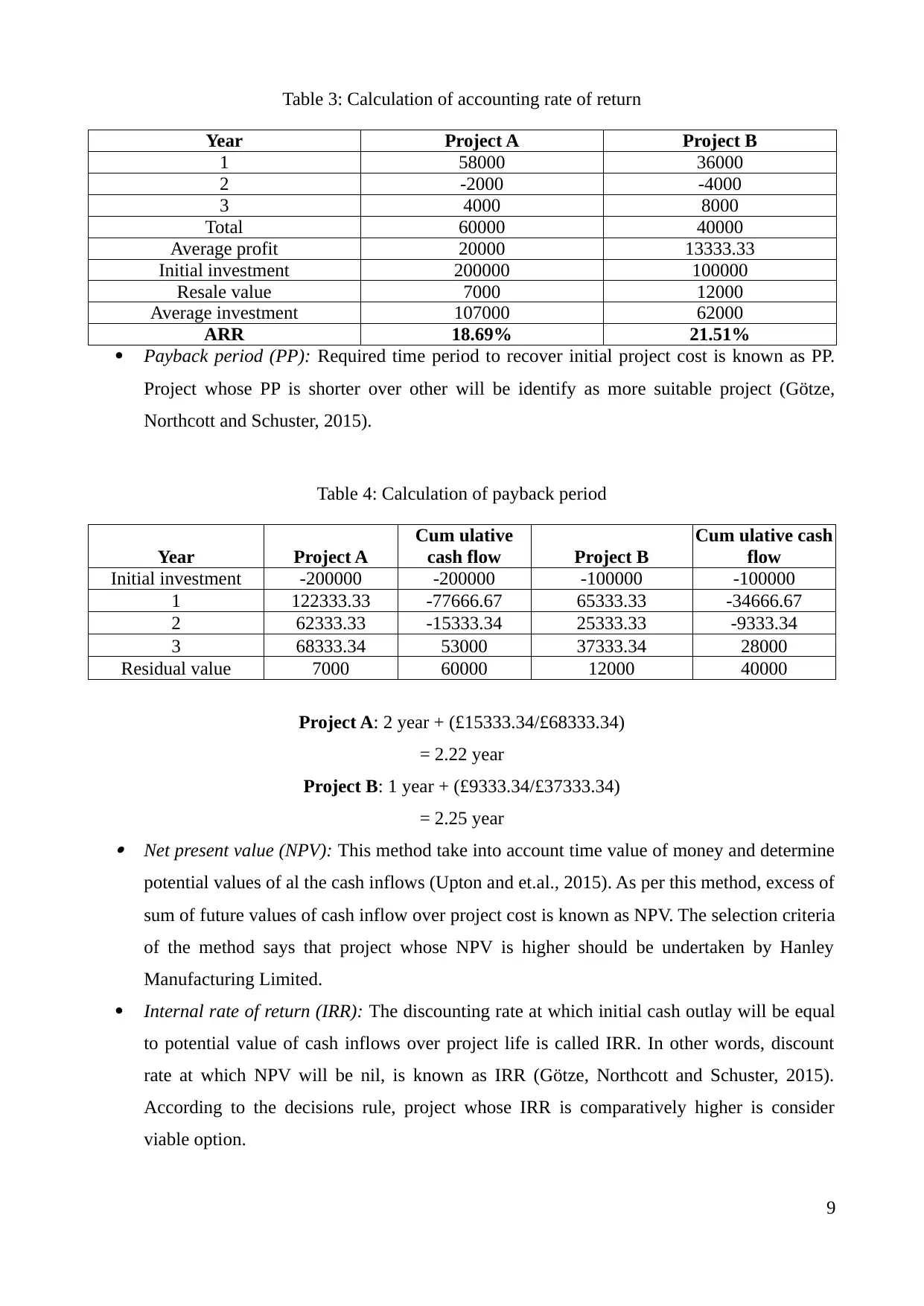
Table 3: Calculation of accounting rate of return
Year Project A Project B
1 58000 36000
2 -2000 -4000
3 4000 8000
Total 60000 40000
Average profit 20000 13333.33
Initial investment 200000 100000
Resale value 7000 12000
Average investment 107000 62000
ARR 18.69% 21.51%
Payback period (PP): Required time period to recover initial project cost is known as PP.
Project whose PP is shorter over other will be identify as more suitable project (Götze,
Northcott and Schuster, 2015).
Table 4: Calculation of payback period
Year Project A
Cum ulative
cash flow Project B
Cum ulative cash
flow
Initial investment -200000 -200000 -100000 -100000
1 122333.33 -77666.67 65333.33 -34666.67
2 62333.33 -15333.34 25333.33 -9333.34
3 68333.34 53000 37333.34 28000
Residual value 7000 60000 12000 40000
Project A: 2 year + (£15333.34/£68333.34)
= 2.22 year
Project B: 1 year + (£9333.34/£37333.34)
= 2.25 year Net present value (NPV): This method take into account time value of money and determine
potential values of al the cash inflows (Upton and et.al., 2015). As per this method, excess of
sum of future values of cash inflow over project cost is known as NPV. The selection criteria
of the method says that project whose NPV is higher should be undertaken by Hanley
Manufacturing Limited.
Internal rate of return (IRR): The discounting rate at which initial cash outlay will be equal
to potential value of cash inflows over project life is called IRR. In other words, discount
rate at which NPV will be nil, is known as IRR (Götze, Northcott and Schuster, 2015).
According to the decisions rule, project whose IRR is comparatively higher is consider
viable option.
9
Year Project A Project B
1 58000 36000
2 -2000 -4000
3 4000 8000
Total 60000 40000
Average profit 20000 13333.33
Initial investment 200000 100000
Resale value 7000 12000
Average investment 107000 62000
ARR 18.69% 21.51%
Payback period (PP): Required time period to recover initial project cost is known as PP.
Project whose PP is shorter over other will be identify as more suitable project (Götze,
Northcott and Schuster, 2015).
Table 4: Calculation of payback period
Year Project A
Cum ulative
cash flow Project B
Cum ulative cash
flow
Initial investment -200000 -200000 -100000 -100000
1 122333.33 -77666.67 65333.33 -34666.67
2 62333.33 -15333.34 25333.33 -9333.34
3 68333.34 53000 37333.34 28000
Residual value 7000 60000 12000 40000
Project A: 2 year + (£15333.34/£68333.34)
= 2.22 year
Project B: 1 year + (£9333.34/£37333.34)
= 2.25 year Net present value (NPV): This method take into account time value of money and determine
potential values of al the cash inflows (Upton and et.al., 2015). As per this method, excess of
sum of future values of cash inflow over project cost is known as NPV. The selection criteria
of the method says that project whose NPV is higher should be undertaken by Hanley
Manufacturing Limited.
Internal rate of return (IRR): The discounting rate at which initial cash outlay will be equal
to potential value of cash inflows over project life is called IRR. In other words, discount
rate at which NPV will be nil, is known as IRR (Götze, Northcott and Schuster, 2015).
According to the decisions rule, project whose IRR is comparatively higher is consider
viable option.
9
⊘ This is a preview!⊘
Do you want full access?
Subscribe today to unlock all pages.

Trusted by 1+ million students worldwide

Table 5: Calculation of Net present value and internal rate of return
Year Project A Project B Pv @10%
Present value
(A) Present value (B)
Initial investment -200000 -100000 1 -200000 -100000
1 122333.33 65333.33 0.909 111212.12 59393.94
2 62333.33 25333.33 0.826 51515.15 20936.64
3 68333.34 37333.34 0.751 51339.85 28049.09
Residual value 7000 12000 0.751 5257.00 9012.00
IRR 15.81% 19.62% NPV 19324.12 17391.66
B. Recommendation to Hanley Manufacturing Limited
On the basis of above results, it can be seen that payback period of project A is shorter than
project B to 2.22 year which is good. But still, decisions can not be taken only on the basis of PP
because it does not take into account time value of money and avoid post payback profitability also.
While, ARR of project B is greater to 21.51% but still, it use profit rather than cash flows in
determining the profit potential of both the proposal. On contrary to this, discounted cash flow
techniques are consider more suitable because it use present value to take into account time value of
money. IRR method suggests that project B is more viable because its IRR is higher to 19.62% than
that of project A to 15.81%. Whereas, NPV of project A is higher to £19324.12 while project B's
NPV is £ 17391.66 which is comparatively less. It indicates that project A will generate high return
on initial project investment hence, it will be more viable. The conflicting results of both the
discounting methods has been incurred due to different cash flow patterns (Götze, Northcott and
Schuster, 2015). NPV is the best techniques of capital budgeting decisions hence, after taking into
account the results, it can be recommended that senior management of Hanley Manufacturing Ltd,
should select project A because it is more viable and provide greater return.
CONCLUSION
On the basis of above results, it can be concluded that Sainsbury is not performing well due
to negative return, worst liquidity position and managerial inefficiency. Hence, potential capital
providers should not make investment in the Sainsbury. Moreover, the report concluded that
controlling expenditures, enhancing revenue, managing inventory, effective utilization of assets are
the ways to ensure effective management of working capital. Furthermore, Green Limited should
increase their cash inflow and control its disbursement so as to manage their cash position to ensure
hazard free operations. Besides this, project evaluation techniques concluded that project A is more
viable project as it will provide greater return to Hanley Manufacturing Ltd.
10
Year Project A Project B Pv @10%
Present value
(A) Present value (B)
Initial investment -200000 -100000 1 -200000 -100000
1 122333.33 65333.33 0.909 111212.12 59393.94
2 62333.33 25333.33 0.826 51515.15 20936.64
3 68333.34 37333.34 0.751 51339.85 28049.09
Residual value 7000 12000 0.751 5257.00 9012.00
IRR 15.81% 19.62% NPV 19324.12 17391.66
B. Recommendation to Hanley Manufacturing Limited
On the basis of above results, it can be seen that payback period of project A is shorter than
project B to 2.22 year which is good. But still, decisions can not be taken only on the basis of PP
because it does not take into account time value of money and avoid post payback profitability also.
While, ARR of project B is greater to 21.51% but still, it use profit rather than cash flows in
determining the profit potential of both the proposal. On contrary to this, discounted cash flow
techniques are consider more suitable because it use present value to take into account time value of
money. IRR method suggests that project B is more viable because its IRR is higher to 19.62% than
that of project A to 15.81%. Whereas, NPV of project A is higher to £19324.12 while project B's
NPV is £ 17391.66 which is comparatively less. It indicates that project A will generate high return
on initial project investment hence, it will be more viable. The conflicting results of both the
discounting methods has been incurred due to different cash flow patterns (Götze, Northcott and
Schuster, 2015). NPV is the best techniques of capital budgeting decisions hence, after taking into
account the results, it can be recommended that senior management of Hanley Manufacturing Ltd,
should select project A because it is more viable and provide greater return.
CONCLUSION
On the basis of above results, it can be concluded that Sainsbury is not performing well due
to negative return, worst liquidity position and managerial inefficiency. Hence, potential capital
providers should not make investment in the Sainsbury. Moreover, the report concluded that
controlling expenditures, enhancing revenue, managing inventory, effective utilization of assets are
the ways to ensure effective management of working capital. Furthermore, Green Limited should
increase their cash inflow and control its disbursement so as to manage their cash position to ensure
hazard free operations. Besides this, project evaluation techniques concluded that project A is more
viable project as it will provide greater return to Hanley Manufacturing Ltd.
10
Paraphrase This Document
Need a fresh take? Get an instant paraphrase of this document with our AI Paraphraser
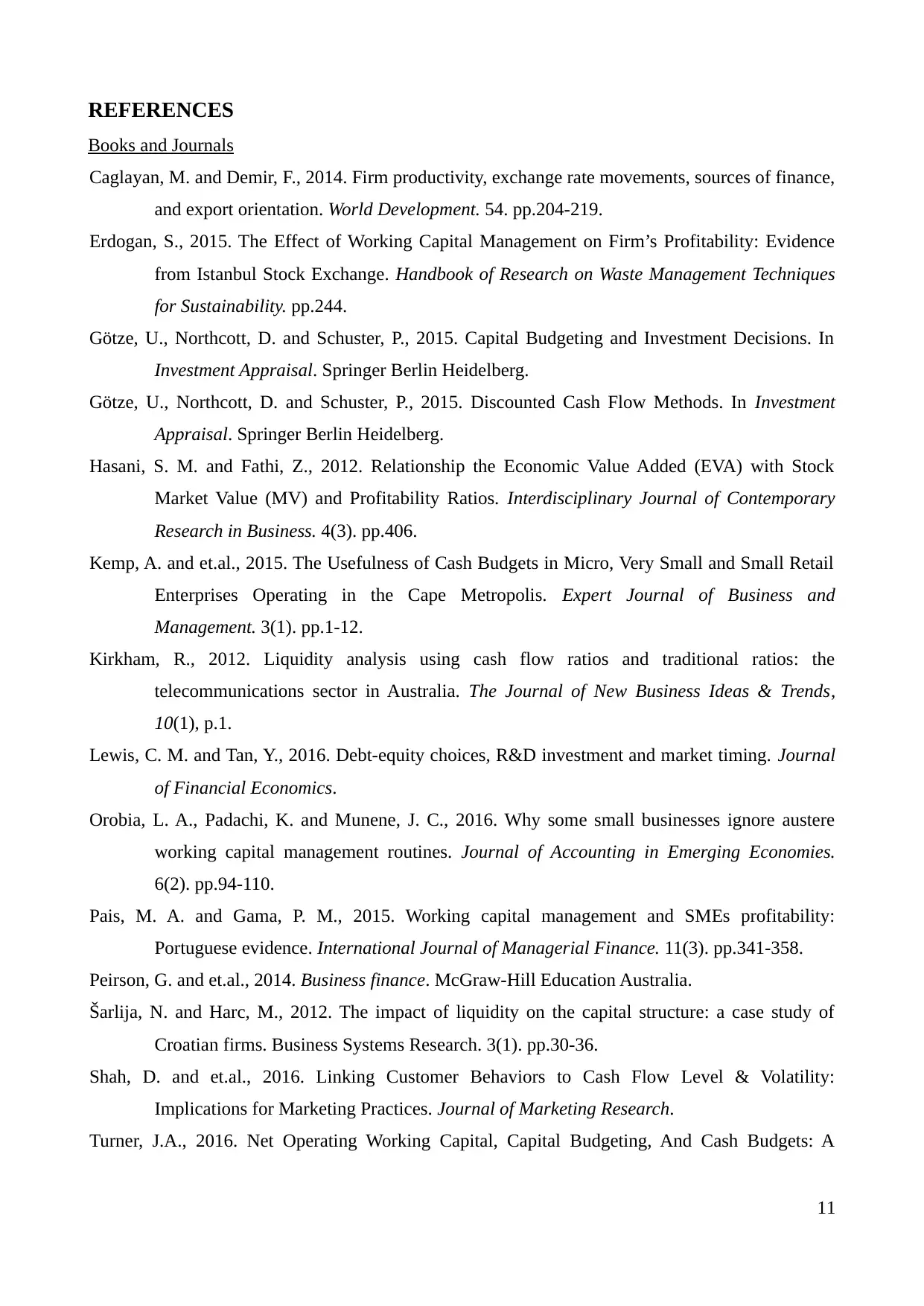
REFERENCES
Books and Journals
Caglayan, M. and Demir, F., 2014. Firm productivity, exchange rate movements, sources of finance,
and export orientation. World Development. 54. pp.204-219.
Erdogan, S., 2015. The Effect of Working Capital Management on Firm’s Profitability: Evidence
from Istanbul Stock Exchange. Handbook of Research on Waste Management Techniques
for Sustainability. pp.244.
Götze, U., Northcott, D. and Schuster, P., 2015. Capital Budgeting and Investment Decisions. In
Investment Appraisal. Springer Berlin Heidelberg.
Götze, U., Northcott, D. and Schuster, P., 2015. Discounted Cash Flow Methods. In Investment
Appraisal. Springer Berlin Heidelberg.
Hasani, S. M. and Fathi, Z., 2012. Relationship the Economic Value Added (EVA) with Stock
Market Value (MV) and Profitability Ratios. Interdisciplinary Journal of Contemporary
Research in Business. 4(3). pp.406.
Kemp, A. and et.al., 2015. The Usefulness of Cash Budgets in Micro, Very Small and Small Retail
Enterprises Operating in the Cape Metropolis. Expert Journal of Business and
Management. 3(1). pp.1-12.
Kirkham, R., 2012. Liquidity analysis using cash flow ratios and traditional ratios: the
telecommunications sector in Australia. The Journal of New Business Ideas & Trends,
10(1), p.1.
Lewis, C. M. and Tan, Y., 2016. Debt-equity choices, R&D investment and market timing. Journal
of Financial Economics.
Orobia, L. A., Padachi, K. and Munene, J. C., 2016. Why some small businesses ignore austere
working capital management routines. Journal of Accounting in Emerging Economies.
6(2). pp.94-110.
Pais, M. A. and Gama, P. M., 2015. Working capital management and SMEs profitability:
Portuguese evidence. International Journal of Managerial Finance. 11(3). pp.341-358.
Peirson, G. and et.al., 2014. Business finance. McGraw-Hill Education Australia.
Šarlija, N. and Harc, M., 2012. The impact of liquidity on the capital structure: a case study of
Croatian firms. Business Systems Research. 3(1). pp.30-36.
Shah, D. and et.al., 2016. Linking Customer Behaviors to Cash Flow Level & Volatility:
Implications for Marketing Practices. Journal of Marketing Research.
Turner, J.A., 2016. Net Operating Working Capital, Capital Budgeting, And Cash Budgets: A
11
Books and Journals
Caglayan, M. and Demir, F., 2014. Firm productivity, exchange rate movements, sources of finance,
and export orientation. World Development. 54. pp.204-219.
Erdogan, S., 2015. The Effect of Working Capital Management on Firm’s Profitability: Evidence
from Istanbul Stock Exchange. Handbook of Research on Waste Management Techniques
for Sustainability. pp.244.
Götze, U., Northcott, D. and Schuster, P., 2015. Capital Budgeting and Investment Decisions. In
Investment Appraisal. Springer Berlin Heidelberg.
Götze, U., Northcott, D. and Schuster, P., 2015. Discounted Cash Flow Methods. In Investment
Appraisal. Springer Berlin Heidelberg.
Hasani, S. M. and Fathi, Z., 2012. Relationship the Economic Value Added (EVA) with Stock
Market Value (MV) and Profitability Ratios. Interdisciplinary Journal of Contemporary
Research in Business. 4(3). pp.406.
Kemp, A. and et.al., 2015. The Usefulness of Cash Budgets in Micro, Very Small and Small Retail
Enterprises Operating in the Cape Metropolis. Expert Journal of Business and
Management. 3(1). pp.1-12.
Kirkham, R., 2012. Liquidity analysis using cash flow ratios and traditional ratios: the
telecommunications sector in Australia. The Journal of New Business Ideas & Trends,
10(1), p.1.
Lewis, C. M. and Tan, Y., 2016. Debt-equity choices, R&D investment and market timing. Journal
of Financial Economics.
Orobia, L. A., Padachi, K. and Munene, J. C., 2016. Why some small businesses ignore austere
working capital management routines. Journal of Accounting in Emerging Economies.
6(2). pp.94-110.
Pais, M. A. and Gama, P. M., 2015. Working capital management and SMEs profitability:
Portuguese evidence. International Journal of Managerial Finance. 11(3). pp.341-358.
Peirson, G. and et.al., 2014. Business finance. McGraw-Hill Education Australia.
Šarlija, N. and Harc, M., 2012. The impact of liquidity on the capital structure: a case study of
Croatian firms. Business Systems Research. 3(1). pp.30-36.
Shah, D. and et.al., 2016. Linking Customer Behaviors to Cash Flow Level & Volatility:
Implications for Marketing Practices. Journal of Marketing Research.
Turner, J.A., 2016. Net Operating Working Capital, Capital Budgeting, And Cash Budgets: A
11
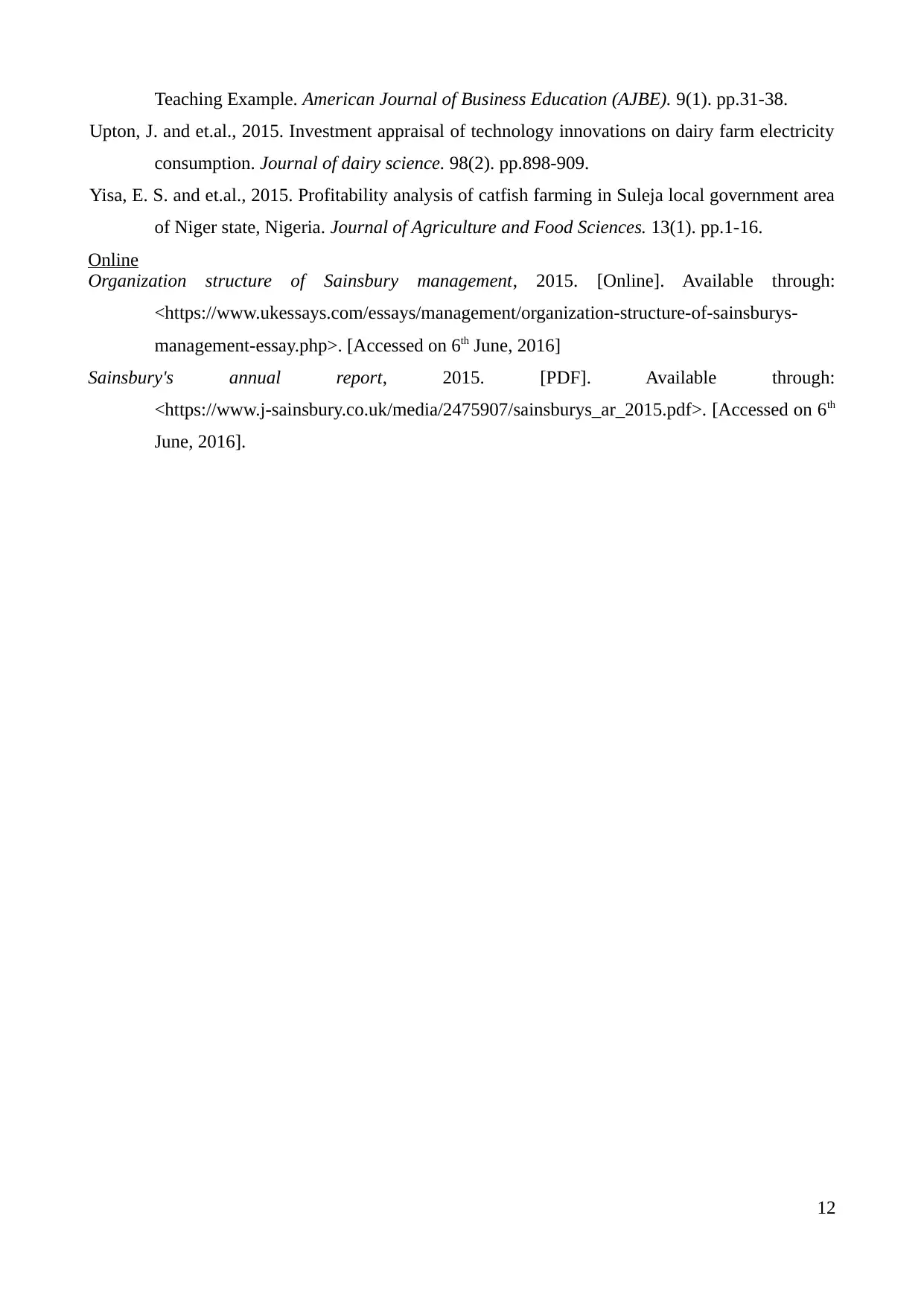
Teaching Example. American Journal of Business Education (AJBE). 9(1). pp.31-38.
Upton, J. and et.al., 2015. Investment appraisal of technology innovations on dairy farm electricity
consumption. Journal of dairy science. 98(2). pp.898-909.
Yisa, E. S. and et.al., 2015. Profitability analysis of catfish farming in Suleja local government area
of Niger state, Nigeria. Journal of Agriculture and Food Sciences. 13(1). pp.1-16.
Online
Organization structure of Sainsbury management, 2015. [Online]. Available through:
<https://www.ukessays.com/essays/management/organization-structure-of-sainsburys-
management-essay.php>. [Accessed on 6th June, 2016]
Sainsbury's annual report, 2015. [PDF]. Available through:
<https://www.j-sainsbury.co.uk/media/2475907/sainsburys_ar_2015.pdf>. [Accessed on 6th
June, 2016].
12
Upton, J. and et.al., 2015. Investment appraisal of technology innovations on dairy farm electricity
consumption. Journal of dairy science. 98(2). pp.898-909.
Yisa, E. S. and et.al., 2015. Profitability analysis of catfish farming in Suleja local government area
of Niger state, Nigeria. Journal of Agriculture and Food Sciences. 13(1). pp.1-16.
Online
Organization structure of Sainsbury management, 2015. [Online]. Available through:
<https://www.ukessays.com/essays/management/organization-structure-of-sainsburys-
management-essay.php>. [Accessed on 6th June, 2016]
Sainsbury's annual report, 2015. [PDF]. Available through:
<https://www.j-sainsbury.co.uk/media/2475907/sainsburys_ar_2015.pdf>. [Accessed on 6th
June, 2016].
12
⊘ This is a preview!⊘
Do you want full access?
Subscribe today to unlock all pages.

Trusted by 1+ million students worldwide
1 out of 14
Related Documents
Your All-in-One AI-Powered Toolkit for Academic Success.
+13062052269
info@desklib.com
Available 24*7 on WhatsApp / Email
![[object Object]](/_next/static/media/star-bottom.7253800d.svg)
Unlock your academic potential
Copyright © 2020–2025 A2Z Services. All Rights Reserved. Developed and managed by ZUCOL.





